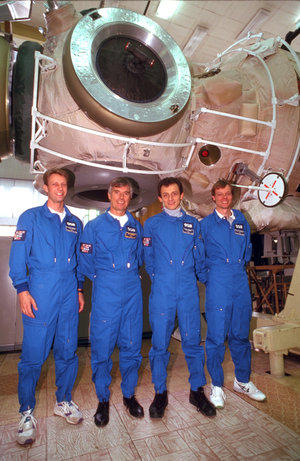Aragatz
Soyuz TM-7 was the seventh expedition to the Russian Space Station Mir.
MISSION STATISTICS
Mission name: Soyuz TM-7
Call sign: Donbass
Number of crew members: 3
Launch:
26 November 1988, 15:49:34 UTC, Baikonur
Landing:
27 April 1989, 02:57:58 UTC, 140 km NE of Dhezkazgan
Duration: 151 days, 11 hours, 8 minutes, 24 seconds
Number of orbits: ~2 450
CREW
Launched:
- Alexander Volkov (2)
- Sergei Krikalev (1)
- Jean-Loup Chrétien (2) - France
Landed:
- Alexander Volkov (2)
- Sergei Krikalev (1)
- Valeri Polyakov (1)
Back-up crew:
- Aleksandr Viktorenko
- Aleksandr Serebrov
- Michel Tognini
(1) number of spaceflights each crew member has completed, including this mission

MISSION HIGHLIGHTS
The original launch date of 21 November 1988 was moved back to permit French president François Mitterrand to attend the launch. It arrived at the Mir station carrying a three-man crew, including French cosmonaut Jean-Loup Chrétien on his second flight into space. Vladimir Titov, Musa Manarov, and Chrétien returned to Earth in Soyuz TM-6.
Alexander Volkov, Sergei Krikalev, and Valeri Polyakov remained aboard Mir. On 1989 April 28, they left Mir in mothballs and returned to Earth in Soyuz-TM 7. The Soyuz-TM land landing system is effective at reducing velocity in the vertical direction. However, according to cosmonaut Sergei Krikalev, winds at the landing site often impart considerable horizontal velocity. As a result, about 80% of all Soyuz descent modules come to rest on their sides. During the rough landing, Krikalev suffered a minor injury to his knee.
Preparations for the first EVA involving a non-Soviet/non-U.S. space traveler forced the cosmonauts to cut short a TV meeting with diplomats from 47 countries on 8 December 1988. On 9 December 1988 Chrétien and Volkov depressurized the multiport docking adapter and clambered outside Mir. Chrétien was first out. He installed handrails, then attached the 15.5 kg Échantillons experiment rack to the handrails by springs and hooks. He also attached electrical wires leading from the rack to Mir's power supply. Échantillons carried five technological experiments with applications to the Hermes shuttle program.
Volkov and Chrétien then assembled the 240 kg ERA experiment. They attached a mount to handrails on the frustum linking the multiport docking unit to the small-diameter portion of the work compartment. After resolving problems with cables linking ERA to a control panel inside Mir, they attached the folded ERA structure to a support arm on the platform. The structure was designed to unfold to form a flat six-sided structure 1 metre deep by 3.8 metre across. From inside Mir, Krikalev commanded the structure to unfold, but to no avail. Volkov then kicked ERA, causing it to unfold properly. According to Krikalev, taking the ERA outside helped relieve the crowding problems. The EVA lasted 5 hours and 57 minutes.
The crew took with them a cassette of the Pink Floyd album Delicate Sound of Thunder (minus the cassette box, for weight reasons) and played it in orbit; this was thought to have been the first rock music recording in space. Pink Floyd attended the launch.





